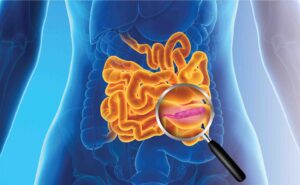EntericPlex
Research Use Only
SpeeDx has developed several concise EntericPlex panels that target common parasitic or bacterial pathogens that cause gastroenteritis.
- Panels currently available are:
- EntericPlex Parasite
- EntericPlex Bacteria I
- EntericPlex Bacteria II
- These single-well qPCR panels are cost-effective and provide rapid results whilst maximizing your sample throughput
- With up to five carefully selected targets, each EntericPlex panel will suit your investigative needs


Why research gastroenteritis?
Gastroenteritis is a leading cause of mortality in children under four, especially in the developing world1, and within the United States it is estimated to cause 179 million illnesses annually2.
In otherwise healthy adults, it is usually uncomfortable but self-limiting. It may be accompanied by abdominal cramps, fever, nausea, vomiting and fatigue and caused by a variety of pathogens (see Table 1).
High risk individuals that develop complications of acute diarrhoea include infants, young children, immuno-compromised and the elderly3.
Table 1. Clinical infectious diarrhoeal syndromes with particular epidemiological settings
| Syndrome | Clinical Features | Epidemiology | Typical Pathogens |
|---|---|---|---|
| Watery diarrhoea | Loose, watery stools Sometimes bloody |
Most common presentation |
|
| Bloody diarrhoea (including immunocompromised patients) |
Bloody stools, sometimes mucous or pus Often abdominal pain, fever, tenesmus Variable presentation Careful investigation required |
Less common |
|
* Commonly associated with visitors or travellers to developing tropical or semi-tropical countries.
† Commonly associated with immunocompromised individuals, such as HIV patients, solid organ or bone marrow transplant recipients, or cancer patients undergoing chemotherapy.
Table adapted and modified from Hewison et al3.
The EntericPlex Parasite panel focuses on the most common parasitic causes of acute infectious diarrheal syndrome: Giardia intestinalis and Cryptosporidium spp., as well as Entamoeba histolytica, Dientamoeba fragilis and Blastocystis spp.
EntericPlex Bacteria I panel detects organisms that account for 95% of bacterial infectious gastroenteritis4. Bacteria cause about 15% of gastroenteritis cases in children, the most common types being Escherichia coli, Salmonella, Shigella, and Campylobacter species5.
To supplement the EntericPlex Bacteria I assay, SpeeDx offers EntericPlex Bacteria II as an extended panel. These targets are designed to further support your research.
Visit our EntericPlex panel product pages for more information:
References
1. https://www.who.int/news-room/fact-sheets/detail/levels-and-trends-in-child-under-5-mortality-in-2020#:~:text=Globally%2C%20infectious%20diseases%2C%20including%20pneumonia,for%20children%20under%205%20years.
2. Schmidt MA, Groom HC, Rawlings AM, Mattison CP, Salas SB, Burke RM, Hallowell BD, Calderwood LE, Donald J, Balachandran N, Hall AJ. Incidence, Etiology, and Healthcare Utilization for Acute Gastroenteritis in the Community, United States. Emerg Infect Dis. 2022 Nov;28(11):2234-2242. doi: 10.3201/eid2811.220247. PMID: 36285882; PMCID: PMC9622243.
3. Hewison CJ, Heath CH, Ingram PR. Stool culture. Australian Family Physician vol. 41, no. 10, October 2012
4. MMWR, CDC, April 19, 2013, Vol 62:15
5. Webb, A; Starr, M (April 2005). “Acute gastroenteritis in children”. Australian Family Physician. 34 (4): 227–31. PMID 15861741
References
1. Schmidt MA, Groom HC, Rawlings AM, Mattison CP, Salas SB, Burke RM, Hallowell BD, Calderwood LE, Donald J, Balachandran N, Hall AJ. Incidence, Etiology, and Healthcare Utilization for Acute Gastroenteritis in the Community, United States. Emerg Infect Dis. 2022 Nov;28(11):2234-2242. doi: 10.3201/eid2811.220247. PMID: 36285882; PMCID: PMC9622243.
2. https://www.worldometers.info/world-population/us-population/
3. https://www.who.int/news-room/fact-sheets/detail/levels-and-trends-in-child-under-5-mortality-in-2020#:~:text=Globally%2C%20infectious%20diseases%2C%20including%20pneumonia,for%20children%20under%205%20years.
4. Sattar SBA, Singh S. Bacterial Gastroenteritis. [Updated 2023 Aug 8]. In: StatPearls [Internet]. Treasure Island (FL): StatPearls Publishing; 2023 Jan-. Available from: https://www.ncbi.nlm.nih.gov/books/NBK513295/
5. Hewison CJ, Heath CH, Ingram PR. Stool culture. Australian Family Physician vol. 41, no. 10, October 2012
6. MMWR, CDC, April 19, 2013, Vol 62:15
7. Webb, A; Starr, M (April 2005). “Acute gastroenteritis in children”. Australian Family Physician. 34 (4): 227–31. PMID 15861741
8. S. Forsythe, J. Sutherland, A. Varnam. Yersinia, Shigella, Vibrio, Aeromonas, Plesiomonas, Cronobacter, Enterobacter, Klebsiella and Citrobacter. In Woodhead Publishing Series in Food Science, Technology and Nutrition, Foodborne Pathogens (Second Edition), Woodhead Publishing, 2009, Pages 763-801, ISBN 9781845693626, https://doi.org/10.1533/9781845696337.2.763.




